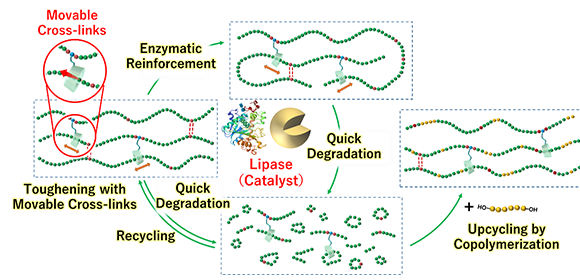
Advanced biodegradable plastics run rings around their predecessors
Researchers from Osaka University produce plastics with both improved toughness and biodegradability by including movable ring-based crosslinks
Achieving a sustainable society requires the development of advanced degradable plastics, or polymers, which are molecules composed of long chains of repeating units. The goal of a resource-circulating society is now one step closer thanks to the efforts of a team from Osaka University that has developed tough biodegradable plastics by including movable crosslinking groups.
In a study published this month in Chem, the researchers have revealed that developing polymers with movable crosslinks not only increases their strength but also promotes degradation by enzymes under mild conditions.
Plastics and polymers need to achieve both desirable performance in terms of durability and strength, as well as triggerable degradation capability to enable their breakdown into useful components for reuse. At present, there is a tradeoff between these factors; i.e., increased toughness makes the polymer more difficult to degrade. The researchers have used movable crosslinks to resolve this problem.
The movable crosslinks are ring-like cyclodextrins, which are threaded on one polymer strand and attached to another, endowing the resulting plastics with increased toughness and durability. Cyclodextrins are nontoxic, biodegradable, and widely available, making them attractive as a polymer component.
“Our polymer design using movable cyclodextrin crosslinks increased polymer toughness by over eight times,” says lead author of the study Jiaxiong Liu. “Stiffness, ductility, fracture stress, and fracture strain all improved because the cyclodextrin groups effectively dispersed local stress.”
The cyclodextrin crosslinks also facilitated degradation of the polymers during subsequent enzymatic treatment because their bulky structure increased the free volume in the polymer network, which improved access of the enzyme to the target cleavage sites on the polymer chains.
“The polymers were readily degraded by Novozym 435, an enzyme that specifically attacks the ester bonds of the polymer backbone,” explains Yoshinori Takashima, senior author. “The presence of the bulky cyclodextrin crosslink groups decreased entanglement and aggregation of the polymer chains, which facilitated the access of the enzyme to the ester bonds for cleavage.” As a result, biodegradability was improved by twenty times compared with that of the polymer without cyclodextrin groups.
These advanced biodegradable plastics can readily be broken down by enzymes into useful precursor molecules that could be reused in further materials, suppressing waste generation and contributing to the development of a sustainable society.
Fig.
Conceptual figure showing the enzymatically sustainable resources of poly(ε-caprolactone)-poly(urethane) (PCL-PU) with movable cross-links catalyzed by lipase as the enzyme.
Credit: Yoshinori Takashima
The article “Exploring enzymatic degradation, reinforcement, recycling, and upcycling of poly(ester)s–poly(urethane) with movable crosslinks” was published in Chem at DOI: https://doi.org/10.1016/j.chempr.2024.09.026.
Related Links
Professor TAKASHIMA Yoshinori (Researcher Directory)
EurekAlert!
AlphaGalileo
Asia Research News
